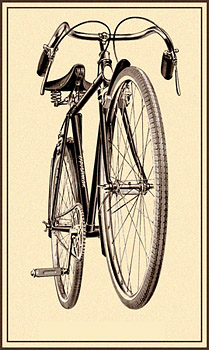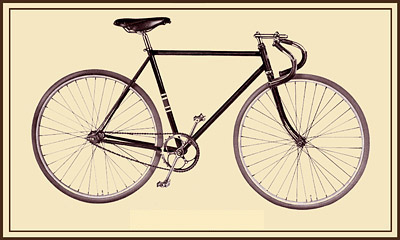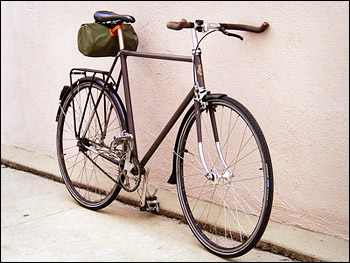2009
One of the hottest trends in cycling in this first decade of the Bicycle Millennium has been the fixed-gear bike.
A fixed-gear bicycle--known as a fixed-wheel in England--is a single-speed bike with no coasting mechanism. That is, if the pedals are turning, the wheel is turning, and vice-versa. In recent years they have been found mainly on velodromes (they are the only types of bikes allowed in track racing) and in use by bicycle messengers. This latter use has led to their current glamorization, though there has always been a coterie of fuddy-duddyish fixed-gear tourists, mostly old men, in the UK.

Kenwood Path Racer, 1895
Slipping through heavy traffic on a fixed-gear is actually easier than on a standard bike, as your speed control comes naturally, through modulating the force of your legs, as a few million years of evolution would have you do.
Fixed-gears are also surprisingly capable on climbs, though you wouldn't think so at first. I know I didn't, though the fixie riders I knew said otherwise. I assumed they were trying to convert me to the "cause," which they were. But once I actually tried riding fixed, I found it to be true. If you choose your gearing carefully, you can climb monstrous hills quite comfortably, and you can climb moderate hills faster than you can on a geared bike, even using an identical gear ratio.
And fixies are very good in bad weather, as you don't depend utterly on rim brakes (which can fade in wet or icy conditions), and the fixed drivetrain both returns more precise feedback about road grip, and allows you to modulate your application of power to the road with greater finesse. This is one reason that road racers often use fixed-gear bikes for winter training. And messengers, of course, must ride even if it is raining or snowing.
There's an irony, though, in the evolution of many present-day riders who reject multi-geared coasting bikes in favor of this latest trend, for fixies are the Ur-bikes, the OGs, in fact, the original safety bicycles: it happens that the safety bicycle was invented nearly twenty years before Sachs produced the first marketable freewheel in 1898.
Until that time, everyone who rode--from gamins to grannies--rode fixed.
Of course, many continued to ride fixed for decades after that. Henri Desgranges, the originator of the Tour de France, despised freewheels and multispeed bikes, saying (in 1902), "I still feel that variable gears are only for people over forty-five. Isn't it better to triumph by the strength of your muscles than by the artifice of a derailleur? We are getting soft...As for me, give me a fixed gear!" The Tour de France didn't get derailleurs until the 1930s.

From the Lewis Lightweights 1939 catalog
Nevertheless, for many decades, fixed-gear bikes were seen mostly on the track, and, as mentioned before, in England, where the fixed-wheel always retained a measure of popularity. Exactly when they became the "weapon of choice" for urban bike messengers is not precisely known. One theory is that an influx of Jamaicans into New York in the 1970s brought the islanders' love of the fixed-wheel bike with them. The story is that the Jamaicans, suffering great poverty, needed bikes that were inexpensive, reliable, and had few parts to wear out or steal, and that, being familiar with fixed-wheel bikes from the island's relationship to Jolly Olde, they latched upon the fixie as fulfilling these requirements.
Once in New York, the same requirements applied, and the need for income drove many of them to take on work as bicycle couriers--New York employing perhaps more messengers than any other city worldwide. The native-born messengers copied them, and things slowly snowballed to the point that now, messenger-chic is a selling point in non-velocipedal commerce, and there's an entire fashion industry offering up messenger-shabby clothing styles to those who will never deliver anything more pressing than themselves to a local bar.
Nevertheless, those qualities of the fixed-gear bicycle that rendered it appealing to both impoverished Jamaicans (if the story be true) and jaded New York City messengers, are still of utility to urban riders of the Bicycle Millennium. Let's look at the primary types a little more closely....
The Track Bike

1939 Schwinn track bike
Track racing being a standard part of the bicycle racing circuit, most of the large companies have always offered track bikes, and many now sell inexpensive streetified versions of same, most famously Bianchi with its "Pista" model, which represented the first commercial offering to take advantage of the growing popularity of fixed-gear bikes in the early 2000s.
A sub-category of the track bike is the keirin bike. Keirin is a peculiar form of track racing popular in Japan, where it is one of the few legal betting sports. To ensure that the competition take place among riders and not corporate engineers, the Nihon Jitensha Shinkokai (Japanese Keirin Association, universally known by its romaji initials of NJS) accredits not only riders but also frames and components, specifying construction details in order to allow as little variation among individual bikes as possible. To have NJS-approved frames and components is a point of pride for many urban hipsters...even though the specifications have no particular application to street riding. The keirin bike, though, is revered as the purest form of bicycle in current production.
So of course, this is what the purists prefer to ride. The badge of pride for many a messenger (or messenger wannabe) is a true track bike under the bum, an uncompromised velodrome sprocket-rocket rattling over frost heaves and cold patch between lines of speeding cars and roaring trucks. By default, these are city bikes of the most extenuated sort, since they live primarily in the city, and are used for work and to reach the destinations of daily living. But not, perhaps, for everyone....
The Path Racer
The path racer is a track bike variant that was popular (in so far as it was ever popular) primarily in England. Its distinguishing characteristic is that it was designed to to race on both pavement and dirt paths, such as canal towpaths. This, in fact, makes it a very good design for daily use, since its handling is more forgiving, and its frame is ruggeder and can accept larger tires. The path racer concept is probably the most suited for a fixed-gear city bike, but unfortunately no one is presently producing one, and in fact most path racers of the glorious past were made by craft framebuilders in small numbers, rather than by corporations.
In 2008, Britain's Pashley Cycle Company reissued an old path racer bike of theirs, now called the "Guv'nor," in an excess of cuteness, but it is a singlespeed (ie, freewheel) bike, not a fixed-wheel.
And Rivendell Bicycle Works has marketed a singular bike called the Quickbeam, which is basically a path racer frame shipped with a flip-flop hub and two chainrings, giving the possibility of four gear ratios which are changed by hand, by flipping the rear wheel about and then, if one so chooses, lifting the chain by hand from one chainring to another. It also ships with freewheels, but a large proportion of its buyers have immediately converted them to fixed, thereby creating a semi-commercially-offered fixed-wheel path racer on their own. It is said to excel on fire trails, towpaths, and other loose-surfaced roads, as well as on pavement--but it goes in and out of production according to the company's whims.
Of course, many custom framebuilders will be willing to build a path racer if asked to.
The Conversion
There's a minor controversy that bubbles up occasionally these days about "conversions," which are simply any bike sold as a geared bike that one converts to a fixed-wheel. Apparently some folks think it's "untrue" to the nature of the converted velo. This attitude goes both ways: many fixed-gear fanatics feel that only a true track bike makes a "proper" street fix. But historical facts argue against both puritanical positions.
Until around the mid-1980s, almost all road bikes, and many mountain bikes, were made with horizontal rear dropouts. (Dropouts are the fittings at either end of the bicycle where the wheel axles slip in, or drop out, hence the name.)
All track bikes have horizontal dropouts, of course, as do bicycles using internally-geared hubs, such as English three-speeds. They are necessary to allow for tensioning the chain so it doesn't sag, which brings a risk of it falling off. You slide the wheel backwards along the dropout slots till the chain is at the proper tension.
A bike equipped with derailleur gearing doesn't need this, as the derailleur has a spring arm that tensions the chain. This is because the chain develops more or less slack as it moves between larger and smaller sprockets. Because of this, for the last couple of decades bicycles intended to use deraileur gears have had non-slotted "vertical" rear dropouts, which simplify wheel alignment.
But derailleurs have existed for many decades--since well before World War II. So why did road bikes continue to be delivered with fixed-gear friendly horizontal dropouts for so long? Was it mindless adherence to tradition?
Not at all. Those bikes were intended to be converted periodically into fixed-wheel machines.
Nowadays, the trend is towards specialized bikes: not just road, city, and mountain, but further subdivisions within those classes: "road bikes," for examples, comprises stage racing, time trial, triathlon, road-sport, and other bikes.
In times not too far in the past, though, road bikes were more versatile, and even a professional racer might not own too many velos. And it was (and often still is) the practice for racers to train on fixed-gear bikes over the winter, when wet or icy weather favored the characteristics of the fixie. And training after the off-season on a fixed-gear is said to smooth out one's pedal stroke.
Come spring, the derailleurs would go back on the frame, and the racing season begin.
In fact, many old British track bikes were drilled for brakes and fenders, though neither is permitted on the track--because the racers would ride to the track on their race bikes! Once there, they'd remove the brakes and fenders, spend the day racing, then remount the street gear for the ride home.

My 1966 Bottecchia Professional conversion
A newer road bike is another matter, since those tend to have vertical dropouts, making it difficult to adjust chain slack. Singlespeeders simply add a chain tensioner--a spring-loaded pulley, in essence half a derailleur--to their bikes. Some fixie lovers with newer road bike frames go through an extended, and expensive, process of trial and error, trying a variety of cog and chainring combinations that approximate the gear they wish to use, in hopes that one will use up just enough chain to allow for the necessary slack--neither too tight nor too loose. Others will simply buy an eccentric rear hub, that is offset around its axle and can be rotated to correct the chain.
It is a measure of the fixed-wheel conversion's resurgent popularity that manufacturers are often now including a road bike model with horizontal dropouts in their lines, so it can, as in the Good Old Days, be converted back and forth from fixed to derailleur transmission at the rider's convenience. And now every maker offers dedicated street-oriented fixed-gear models to the public, bringing us full circle, with refined technology elevating the original concept to a level that can perhaps be called sublime.
Of course, once the fixed gear trend gained momentum, it jumped to mountain bikes as well, so there has arisen a coterie of fixed-wheel MTB riders (as well as much more numerous singlespeeders). Not to mention the small coterie of fixed-gear tourists, in the grand English tradition.
But it is as a city bike that the fixie most brightly shines, easing through the heaviest traffic, tracking over rain-wet streets, or crunching through snow, locked to poles, racks, meters, and railings all over town, a tribute to efficiency, simplicity, and now--once again, after nearly a century of obscurity--style.
Text and photo by Richard Risemberg

